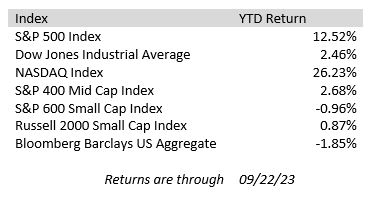Last week was a bit challenging for stock markets. The Dow Jones Industrial Average was down 1.89% for the week. The S&P 500 followed suit down 2.91%, and the NASDAQ lost 3.61% for the week. Meanwhile, small-cap stocks tumbled even further as the Russell 2000 decreased 3.81%. The most widely followed topic last week was the Federal Reserve meeting held on Wednesday. As anticipated, the Fed left rates unchanged. However, the Fed’s dot-plot indicated the potential for one more hike before the end of 2023. It also projected two rate cuts next year, which is two fewer than previously forecasted for 2024. When asked if a soft landing was a “baseline expectation,” Fed chair Powell said a soft landing “was a plausible outcome,” but added that was, “ultimately decided by factors outside of our control.” The Feds’ focus is to restore price stability. All this was signaling higher rates for longer than previously thought.
The potential for a government shutdown continued to grow last week as the September 30th fiscal year end fast approaches. A small group of hardline Republicans is pushing for deeper cuts to spending than the previously agreed upon deal passed in June of this year between President Biden and House Speaker Kevin McCarthy. That deal was to suspend the debt limit until Jan. 1, 2025, and had additional cuts to the deficit of $1T over the next 10 years. It passed with a vote of 63-36 in the Senate. Many experts believe that if there is a shutdown, the first since 2019, it will be short. According to Morgan Stanley, a review of the last 20 government shutdowns since 1976, shows that they generally “appear to have limited impact on the economy.”
While some progress has been made in Hollywood with a tentative agreement Sunday night between the Writers Guild of America and Hollywood studios, the United Auto Workers expanded their walkout with 38 more GM and Stellantis locations. According to UAW President Shawn Fain, talks with Ford saw “real progress” so they did not expand strikes for Ford locations. The UAW did continue the original strike at a Ford plant since there are still significant gaps to close.
Housing starts dropped 11.3% month-over-month in August to 1.283M, marking the lowest level since June 2020. The market expected a small drop to 1,440 so this was a downside surprise of -157.0K. Existing home sales dropped to 4,040 from 4,070. It was expected that they would increase to 4,100. High mortgage rates are clearly reducing consumer demand for purchases and causing current homeowners to defer different home purchases until rates come down.
There are a lot of economic releases this week, but here are a few highlights we are watching. Consumer confidence is expected to drop a bit from 106.1 to 105.0 reflecting the ongoing potential for a government shutdown. US GDP comes out and is expected to show continued strength from the second quarter. The PCE (Personal Consumption Expenditure) index, which is the Fed’s preferred inflation gauge, is expected to be up moderately, reducing the annual or year-over-year rate down to 3.8%.


